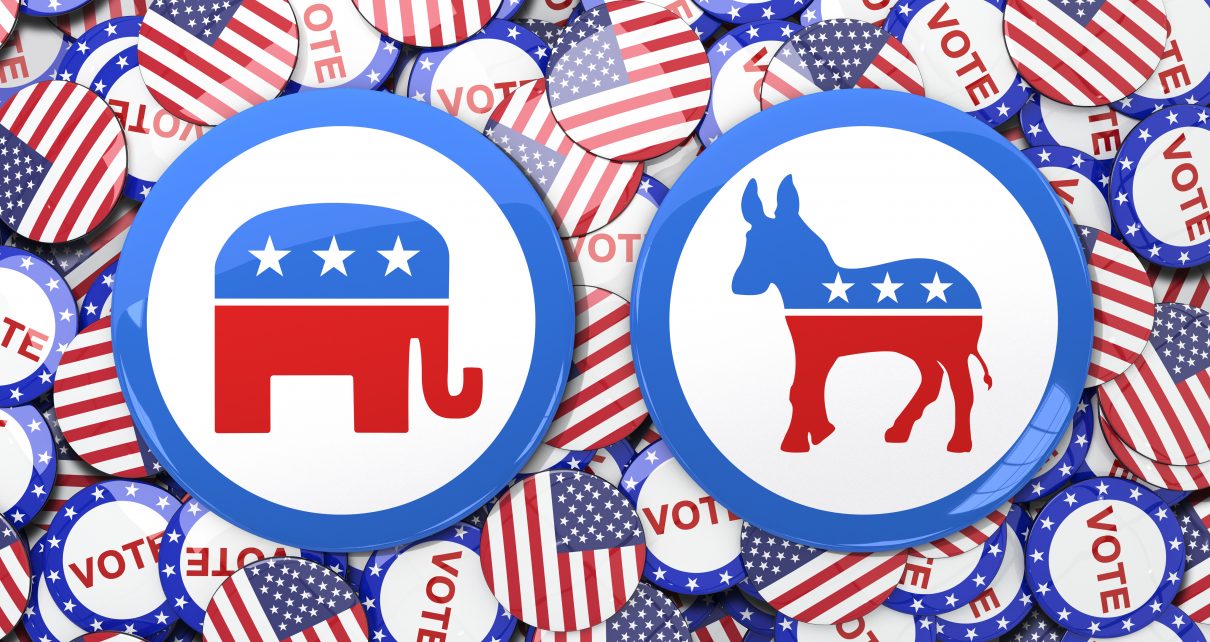
Democrat and Republican vote buttons. (Image: vectorfusionart/Shutterstock)
Ringside: The Death and Resurrection of CAGOP
The best strategy Republicans can adopt on social issues is to just let the Democrats continue to go off the deep end
By Edward Ring, June 11, 2024 6:36 am
 California’s GOP is dead. Candidates for state office rarely gain more than 40 percent of the vote, and GOP representation in the State Senate stands at half that, 20 percent (8 seats out of 40), and in the State Assembly 21 percent (17 seats out of 80). No Republican has been elected to a statewide office since Arnold Schwarzenegger got reelected in 2006.
California’s GOP is dead. Candidates for state office rarely gain more than 40 percent of the vote, and GOP representation in the State Senate stands at half that, 20 percent (8 seats out of 40), and in the State Assembly 21 percent (17 seats out of 80). No Republican has been elected to a statewide office since Arnold Schwarzenegger got reelected in 2006.
The conventional explanations for CAGOP’s demise are well trod and tedious. Prop. 8 in 2008 and Prop. 187 way back in 1994 stamped Republican candidates as homophobes and racists, respectively. The stigma stuck, glued into the electorate’s psyche thanks to decades of campaigning and lobbying funds that have overwhelmingly favored Democratic candidates and causes. And then Donald Trump came along. You may love him or hate him, but for millions of California’s thoroughly prepped partisan voters, you couldn’t possibly invent a more terrifying boogieman.
There are other factors however, less publicized, that have also contributed to Republican irrelevancy in California. The party is bitterly divided, thanks to a schism that began around 2006 and has widened with every passing year. It was around 2006 when Schwarzenegger performed a political pirouette, seemingly overnight transforming from a politician who dared to confront the all-powerful government unions to a conciliatory moderate willing to sign the Global Warming Solutions Act.
If Schwarzenegger’s defection in 2006 left the GOP divided between voters who liked the old Schwarzenegger vs. voters who liked the new Schwarzenegger, two years later that gap widened when Prop. 8 qualified for the ballot. It was narrowly approved by voters, but alienated GOP voters and donors who occupied the “fiscal conservative but social liberal” category. And riding into a splintered party came billionaire Meg Whitman. Running for governor, she managed to squander $177 million on a mediocre campaign, including $30 million of other people’s money. Her campaign, in retrospect, might be distilled as follows: “I’m a woman and I’m not a bigot, please vote for me.” Jerry Brown tore her to shreds.
In the wake of the Whitman debacle, big donors to the GOP felt taken for a ride. They started sitting out campaigns in California, preferring to support GOP candidates in smaller and more competitive races in other states. It was also in 2010 that California’s voters approved the Top-Two primary scheme, something that was promoted as a way to bring less extreme candidates into the general election. And to complete the 2010 trifecta, it was in that year that business groups made a conscious decision to start supporting “pro-business” democrats. In one year, the GOP in California managed to lose the confidence of major individual donors, much of their support from the business community, as well as what had been up till then a guaranteed spot on the November ballot for their candidates.
A savvy pro-business Democrat once told me, when asked why on earth he’s a Democrat when he walks like a Republican, talks like a Republican, and acts like a Republican, said something that surprised me at the time. “We’ve already got the Republicans,” he said. That makes perfect sense. While Republican voters and the vanishing minority of Republican candidates who get elected will perseverate over abortion and the transgender agenda, they nonetheless reliably support anything the business community needs. As California’s business community plays perpetual defense, they know that to stop the truly insane, job killing proposals coming out of the Democratic party, they’ve already got 20 percent of the vote. If they can get a bit more than one-third of the Democratic legislators to see reason, they can stop a bill.
Why on earth would any rational business person invest in California’s Republican party? They’re more dead than alive. And to the extent there is a vestige of life left in them, they’re already always in your corner.
The resurrection of CAGOP may not require a miracle, but it probably does require a few more missteps by California’s Democrats. With one piece of legislation after another warped by extremists, they are contending with their own insurgency. A few more economic hiccoughs that will have been completely preventable, and no amount of money will convince Californians to keep supporting the lunacy.
In the short run, California’s GOP will never resolve the social issues that divide it, any more than these social issues will be quickly resolved by society at large. Despite their urgency, these are moral questions that will take a generation or more before a new consensus is established. The best strategy Republicans can adopt on social issues is to just let the Democrats continue to go off the deep end. In the meantime, California’s Republicans can unite over issues that affect everyone in the state, issues for which the Democrats have absolutely and obviously failed. They are education, crime, and the cost-of-living.
Decisive solutions to these issues are allegedly controversial according to the special interests that realize ongoing profit and power from the failed agenda they enforce. But they’re not controversial. Californians need school choice, a restoration of criminal deterrence, and massive deregulation to allow the private sector to increase the supply and lower the cost of every essential – housing, food, building materials, energy, water.
It won’t be easy to form a coalition powerful enough to go toe to toe with the special interests that currently own the Democratic party – government unions, “nonprofits,” the environmental lobby, trial lawyers, and leftist billionaires. But a potential coalition is there, if leaders can be found to build it. California’s business community could unite behind candidates that agree on specific policies to address affordability, safety, and quality education. Some of California’s private sector unions may also recognize that new approaches to these issues will benefit working families. Responsible environmentalists could choose to start balancing the needs of people with the needs of the environment. And a growing coterie of billionaires are already deciding to violate the groupthink of their peers and support solutions that will preserve freedom and enable broad based prosperity.
The biggest risk to CAGOP’s resurrection is to mistake rhetoric for genuine reform. Fighting for school choice, laws with teeth to deter crime, and an agenda that truly restores affordability and abundance to working families is going to be a fight. It will take firm resolve and unity. Words are cheap, and credibility has to be earned. But if enough candidates stand up for these three goals, and refuse to compromise on the core elements of this new agenda, California can realign.
- Ringside: Will the Delta Pumps Operate at Capacity this Winter? - December 18, 2025
- Ringside: Will Advocates for More Water Supply Projects Find Unity? - December 11, 2025
- Ringside: EVs and California’s Future Demand for Electricity - December 4, 2025





‘The only thing necessary for the triumph of evil is for good men to do nothing.’ Without a strong moral message AND following through on that message the GOP will go nowhere as they should. Our problems today are more the fault of the GOP and their fake conservatives than the demonic left.
People do not respect weakness. The GOP is the weakest bunch of saps I have ever seen or heard of.
CW – as stated: “he biggest risk to CAGOP’s resurrection is to mistake rhetoric for genuine reform. Fighting for school choice, laws with teeth to deter crime, and an agenda that truly restores affordability and abundance to working families is going to be a fight. It will take firm resolve and unity. Words are cheap, and credibility has to be earned. But if enough candidates stand up for these three goals, and refuse to compromise on the core elements of this new agenda, California can realign.”
My comment was my view of the GOP, not of your article which I mostly agree with. Keep up the good work.
Sadly the GOP has not mistaken rhetoric for reform. They use rhetoric to get elected and then do nothing (as planned). The GOP is an arm of the Democrat party even though there are a few honest people who try to get something positive done but when they do their biggest opponents are the so-called conservatives in the GOP.
CA GOP is full of traitorous RINOs? CA GOP Chair Jessica Millan Patterson is not a fighter? CA GOP has been reduced to being a feckless foil for Democrats?
(https://calmatters.org/commentary/2024/03/california-election-republicans-foil-democrats/)
Yep! I donated to and walked precincts for Valadao and he back stabbed President Trump. I don’t even live in his district. I will no longer do anything for any GOP candidate in CA. Most of them are RINOs.
New local group: …..”Conservative Republicans” ……formed by those frustrated with the local official Republican party unit and their rigid litmus tests. This group is attracting unlabeled conservatives, as well as non-RINO registered GOP. It is younger and energetic. And hopes to work cooperatively with the local official Republican Party.
There is plenty of room for a spectrum of conservative interest groups. as well as providing independent balance for all local non-partisan elected positions.
Younger California voters are refusing to sign up as either Democrats (party of SEIU and the teachers unions) or Republican (old Guard and moribund). Instead they register as Independents. It is now our job to win them over with principles and policies that work best for all of California; not just SEIU and the teachers unions.
Good to know, Jaye. Thank you.
Yes, Jaye. We have a local “Conservative Republicans” group that meets separately from the old Republican group (that still relies on the dinner cruise – invited speakers forum) agenda. The newer group is younger and they do door knocking to gather support; for example to promote new people for election to the central committee.